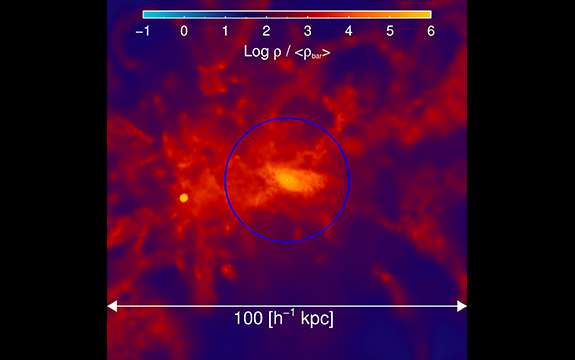The great galactic recession

A simulated universe created by Swinburne University of Technology and The University of Melbourne has revealed galaxies emerging in the first billion years after the Big Bang were experiencing a recession.
It has long been imagined that the first galaxies formed after the Big Bang were rapidly growing, turning huge clouds of pristine gas into stars at rates thousands of times greater than what we see in the Milky Way today.
However, new modelling inspired by economics theory has instead revealed the galaxies weren't forming as fast as they could have.
Swinburne astronomer Associate Professor Alan Duffy created supercomputer simulations of the early universe treating the complex forming galaxies as a simple economical model with raw materials arriving (under gravity) and being processed (into stars).
What surprised Associate Professor Duffy and colleagues was that not all the gas that could form stars was being turned into stars.
"In the universe around us today, we think of galaxies in balance, raising their internal rate at which they form stars until it reaches the rate at which gas arrives," says co-author Professor Stuart Wyithe, from The University of Melbourne.
"If the internal consumption rate is too high then the gas is used up and the galaxy starves until enough new material arrives to replenish their supply. We thought that would occur in the early universe too, but the picture was totally wrong.
Associate Professor Duffy explains that first galaxies have such a torrent of cold gas flowing into them that they simply can't keep up.
"The internal gas consumption can't rise fast enough with supply outstripping demand or in economics terms the galaxy is in recession. It's only when the universe expands over billions of years do the rates of material falling into these growing galaxies slow enough to allow the galaxy to find that balance we see today," Associate Professor Duffy says.
Collectively known as Smaug the gas simulations featured in this work are part of the larger series DRAGONS (Dark-ages, Reionization And Galaxy-formation Observables Numerical Simulation) led by University of Melbourne's Professor Stuart Wyithe and funded by Professor Wyithe's Australian Research Council Laureate Fellowship.
The research has been published in the Monthly Notices of the Royal Astronomical Society.
More information: Alan R. Duffy et al. Dark-ages reionization and galaxy formation simulation – IX. Economics of reionizing galaxies, Monthly Notices of the Royal Astronomical Society (2017). DOI: 10.1093/mnras/stx1242
Journal information: Monthly Notices of the Royal Astronomical Society
Provided by Swinburne University of Technology





















